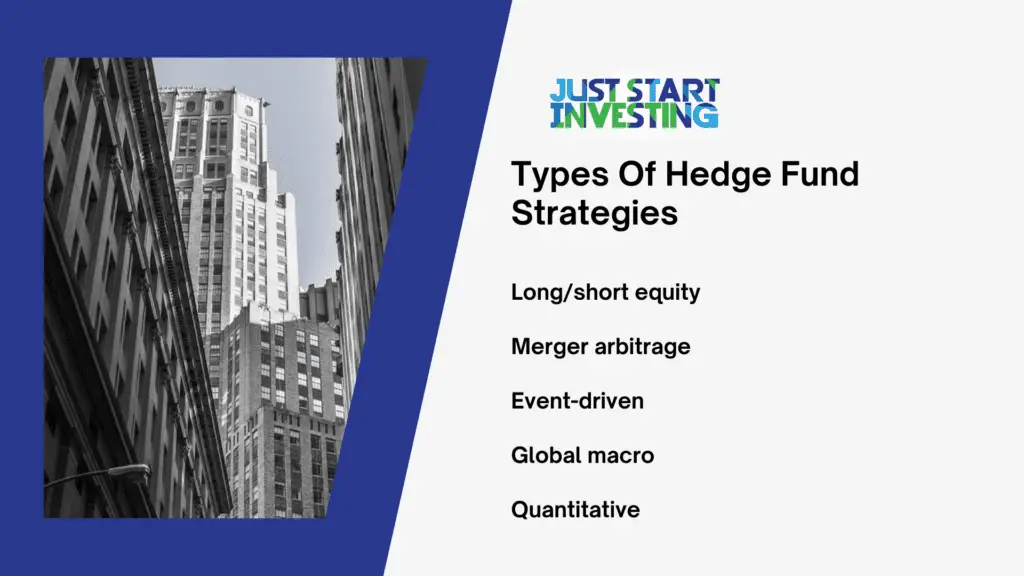What is a hedge fund? Hedge funds are special types of investment instruments in which individuals and institutions pool their capital together to invest in various assets while relying on complex strategies to build their portfolios and manage their risks. As a result, rich individuals can invest part of their money into hedge funds as a way to beat the market’s average return.
Unlike mutual funds, hedge funds invest in a wide range of assets rather than merely stocks and bonds.

In contrast to most investment funds, hedge funds take unconventional approaches to achieve above-average returns. Their main goal is to generate an absolute return. In addition, investing in them was meant to generate profits, regardless of the market conditions. Thus, they claim to be immune to market forces, despite an analysis of performance suggesting otherwise.
The popularity of these bonds was attributed to the bull market in the US prior to the great depression in the 1920s. The assets managed by hedge funds total several trillion dollars today.
In general, hedge funds have similar legal structures, similar investment strategies and charge investors relatively similar fees.
However, in order to properly define a hedge fund, we must first dig a little deeper!
How Hedge Funds Work
Hedge funds admit only accredited investors as participants. In order to qualify as an accredited investor, one needs to have a liquid net worth of at least $1 million or an annual income of at least $200,000. Investors with that much wealth are assumed to have a certain level of financial sophistication; thus, the SEC allows accredited investors to invest in less-regulated securities offerings.
A hedge fund is structured as a limited partnership. Hedge fund companies are general partners, while investors are limited partners. Limited partners contribute money to the hedge fund, which invests it on their behalf.
Because hedge funds don’t experience the same regulation as mutual funds, they can take a more aggressive approach in their investment since they are non-regulated by the Securities and Exchange Commission. Often, managers employ advanced strategies, including leverage, short positions, and derivatives such as options, and can invest through various markets, from stocks to bonds to commodities to real estate to blockchain technology. The potential for making money is almost endless.
There is often little liquidity in hedge fund investments. The investment can only be made or withdrawn within certain periods, with some locking up the investment for a number of months or even years. Fund managers are able to take more aggressive positions by doing things this way since they do not have to provide liquidity to investors all the time.
How hedge funds make money
Fees for hedge funds are usually split between management and performance fees.
Typically, hedge fund companies charge a 2% management fee. Each investor’s net asset value determines this fee. Therefore, for a $1 million investment, you’ll pay approximately $20,000 in management fees. Fund managers may receive compensation directly from this fee in order to cover the operation costs of the hedge fund.
Fund managers are responsible for developing investment portfolios and managing cash inflows and outflows. The fund’s investment decisions are immediately made by them, along with the strategies it will employ.
Performance fees, however, are typically 20% of profits. In this case, if you invest $1 million and the hedge fund manager makes a profit, they’re taking an additional $40,000 (20% of $200,000. Funds that do poorly and lose money do not incur additional fees.
Since the 2008 financial crisis, hedge fund companies have faced pressure to lower their fees because hedge funds have underperformed since then.
Hedge Funds Characteristics
Since there are similarities between mutual and hedge funds, let’s try to differentiate the two. How do you tell a hedge fund from a mutual fund? Here are a few big differences between the two.
- Hedge funds do not accept small investors
Hedge funds can accept money only from “qualified” investors.
Since hedge funds are not strictly regulated by the Securities and Exchange Commission, such rules must be imposed. Hedge funds are eligible to take on potential risks only if they have qualified investors.
- Managers of hedge funds can exercise a wide degree of freedom
Only the hedge fund’s management mandate limits the investment universe. The best hedge funds invest in everything—land, real estate, stocks, derivatives, currencies, etc.
Comparatively, mutual funds focus on stocks and bonds and aim to achieve long-term growth.
- The use of leverage is common among hedge funds
Taking aggressive short positions allows hedge funds to multiply their returns by borrowing money.
Leverage can wipe out hedge funds, as well as other major segments of the economy, as was seen during the financial crisis of 2008.
- A different fee structure
The average fee for mutual funds has decreased substantially in recent years, reaching 0.5% in 2020.
On the other hand, Hedge funds charge “2-and-20” fees, or 2% of assets under management and 20% of the profit.
Types Of Hedge Fund Strategies

Investing in hedge funds involves a variety of strategies and sub-strategies. In this article, we’ll examine the five most common types:
- Long/short equity:
Based on their research, the managers of funds buy stocks they believe are promising, and short stocks they believe are overvalued. Through this strategy, market risk can be reduced because the long positions are offset by the short positions.
When the long position outperforms the short position, the fund makes money.
- Merger arbitrage:
An investment manager will seek opportunities where mergers and acquisitions aren’t reflected entirely in the security price. To acquire a target, they can purchase its shares and sell their own at an exchange ratio based on the announcement of the acquisition share exchange. In case the merger goes according to plan, the deal will succeed, but there’s a risk that it could change or that regulatory roadblocks could prevent it.
- Event-driven:
In distressed companies or companies that have already filed for bankruptcy, managers usually buy senior debt. Managers assume they will receive close to the face value of the debt they buy when a company restructures, while junior investors and debt holders may have little chance of recovering any value.
- Global macro:
Investing in hedge funds will involve analyzing how economic trends will impact the world’s financial systems, including changes in exchange rates, interest rates, or commodity prices. Currency forwards are often the best investment opportunities most affected by those changes.
- Quantitative:
To find trading opportunities, hedge funds develop algorithms that analyze large data sets. A trading system will often execute the trade automatically, and management will simply analyze and adjust it as necessary based on the results. The case of high-frequency trading illustrates quantitative trading in action.
How To Invest In a Hedge Fund
If you are looking to invest in hedge funds, you should first research available funds. For help locating potential hedge funds, you’ll probably want an experienced financial advisor. When you have examined the funds’ fund managers and investment goals using Form ADV, you should contact a hedge fund to find out what the minimum investment requirement is.
It’s also necessary to prove that you’re an accredited investor. However, there are no standardized methods or accreditation bodies. The technique used for evaluating you varies from fund to fund. A financial institution, an investment advisor, or an attorney would need to verify your income, assets, and debts, as well as your experience.
Individuals with the means to diversify into hedge funds may be attracted to them by the reputation of the manager, the specific assets the fund invests in, or the unique strategy they employ.
Some Interesting Statistics on Hedge Funds
Researching hedge funds beforehand would be necessary if you are interested in becoming one. Therefore, we did a little digging in order to present you with some data you might find useful in better understanding everything connected to hedge funds and making your first move towards investment!

Percentage Of Assets Managed By Hedge Funds
In the following link, you can see that the percentage of assets managed by hedge funds decreased from $1.9 trillion at the beginning of 2008 down to $1.1 trillion by the end of the year.
According to Hedge Fund Research, Inc. In 2008, hedge funds lost an average of 18.7% of their assets. In addition, investors would have withdrawn money if hedge fund managers hadn’t invoked gates, which are contractual limits on how much money can be withdrawn within a certain period.
Global Macro Funds
In the Great Recession, global macro funds made money on currencies, interest rates, futures, and equities by using their analysis of world economic trends. In 2008, these funds gained 5%, while the S&P 500 lost 40%. From 2002 to 2007, the fund’s returns lagged the market by an average of 2.7%, which may account for their 11% share of the market at the year-end.
The main advantage of global macro funds is that they do not leverage their results, which helped them perform well when most other funds were down in 2008.
Furthermore, the global macro is attractive because no concern is involved with the size of assets since the currency market is so huge and because derivatives are based on the value of the underlying. The price of stocks and bonds, on the other hand, fluctuates much more when the supply and demand of the security change.
Long-Short Funds
In long-short funds, investors buy long or sell short. As a result of declining trading costs on the decimalization of stock prices and especially after the stock market bubble burst in 2000, they made money whether the market went up or down, increasing their market share to 29% at the end of 2007. Nevertheless, they lost an average of 28% in 2008.
Event-Driven Funds
The event-driven funds make money by forecasting market movements based on surprises in earnings or reorganizations in corporate organizations, which has increased their market share to 24%. But, overall, these funds lost 21.5% on average in 2008.
Overall, according to Credit Suisse Group AG’s AES subsidiary, 65% of hedge funds were global macro funds in 1994, 15% were long-short funds, and 7.4% were event-driven funds.
Value Of Assets Managed By Hedge Funds
Another research shows us the value of assets managed by hedge funds worldwide from 1997 to 2020.
Throughout the 1990s, the hedge fund industry boomed, and the markets for assets managed by hedge funds around the world grew steadily until 2007. Then, as a result of the financial crisis, the value dropped the following year significantly and didn’t recover until 2013.
The value of hedge funds in the United States was over 3.8 trillion dollars in 2020, with the majority of assets managed by hedge fund managers.
To understand and better visualize this data, we recommend you check out this link!
The bottom line: What is a hedge fund?
A hedge fund provides access to one manager’s investment strategy, but the cost is high. Even those eligible to invest in hedge funds may be better off with a less costly approach to investing than hedge funds.
Before investing in hedge funds, it is advisable to read the prospectus carefully since the strategies, risks, potential returns, and volatility of these funds differ significantly.
Risk is inherent in any investment, so if in doubt, seek independent advice!
Want to learn more things about investing? Check out these articles:
- What are the benefits of investing in real estate?
- Stock Market Crash 2021: Ultimate Predictions
- 5 Stock Trading Tips for Beginners

Just Start Investing is a personal finance website that makes investing easy. Learn the simple strategies to start investing today, as well as ways to optimize your credit cards, banking, and budget. Just Start Investing has been featured on Business Insider, Forbes, and US News & World Report, among other major publications for its easy-to-follow writing.

